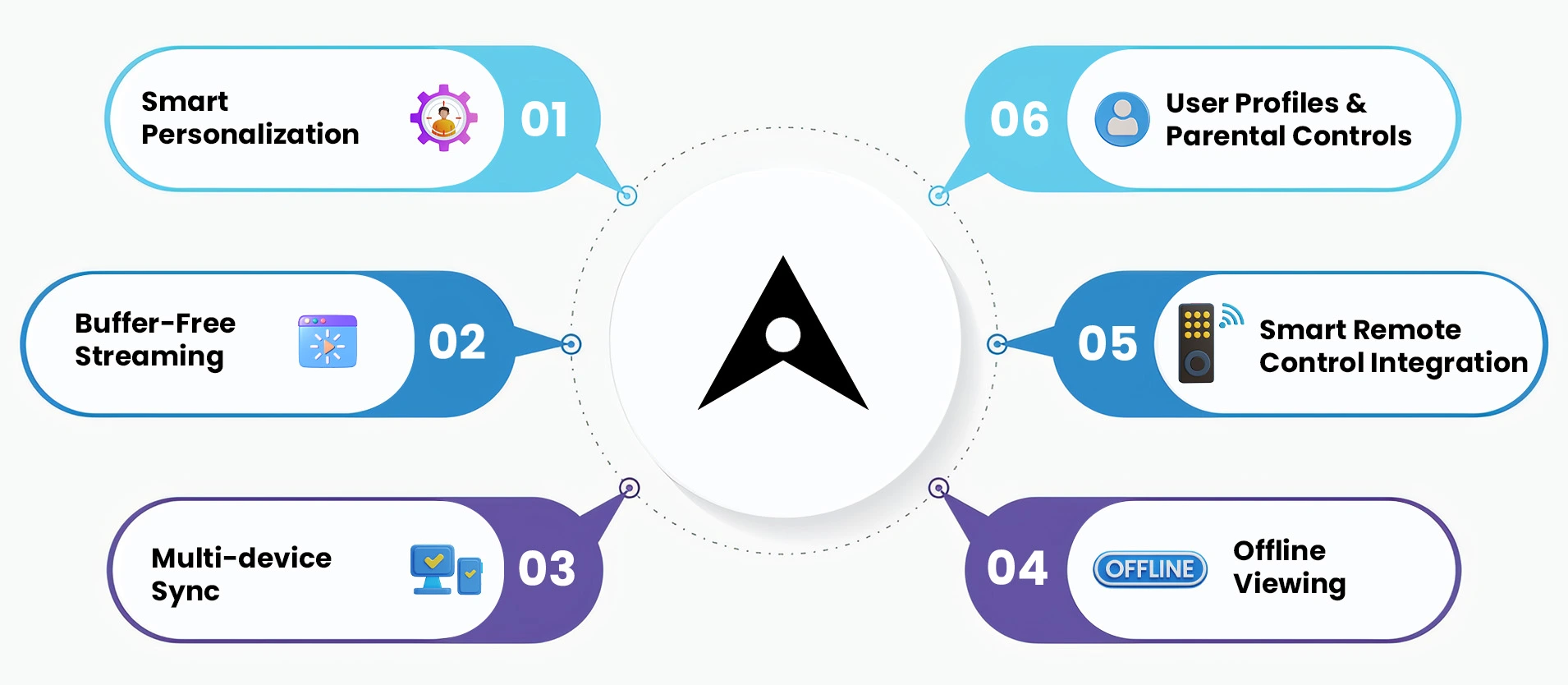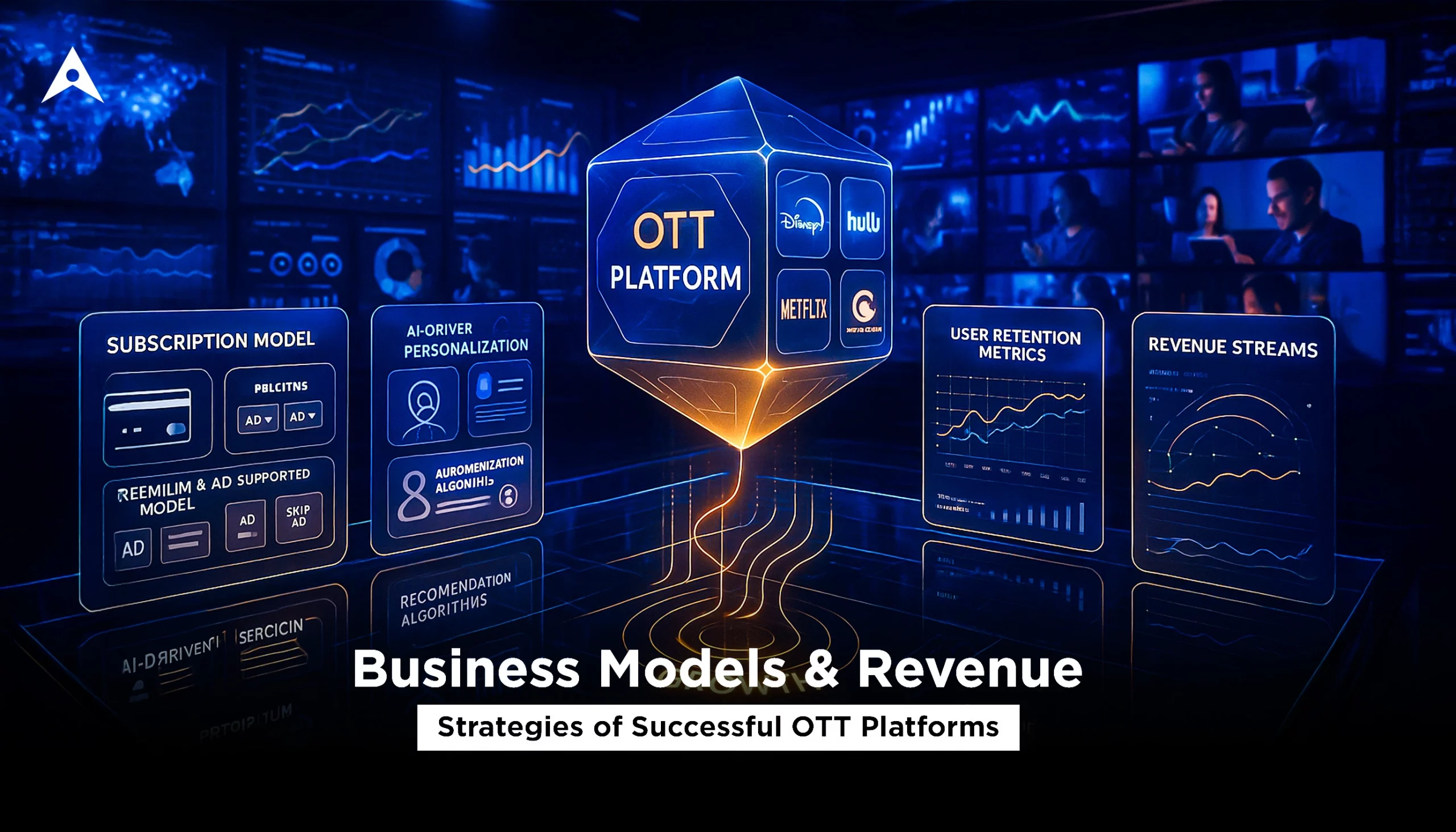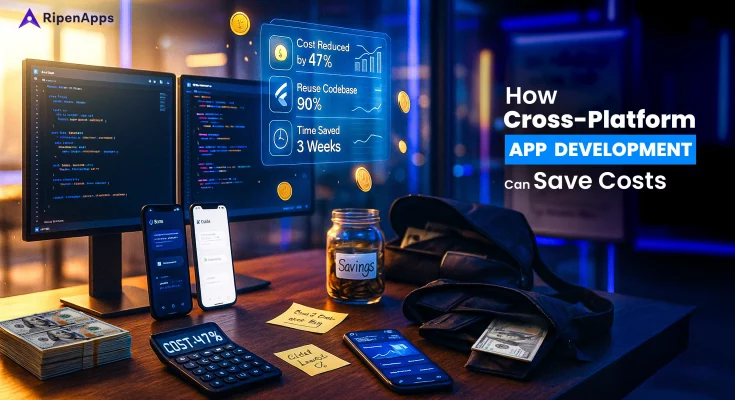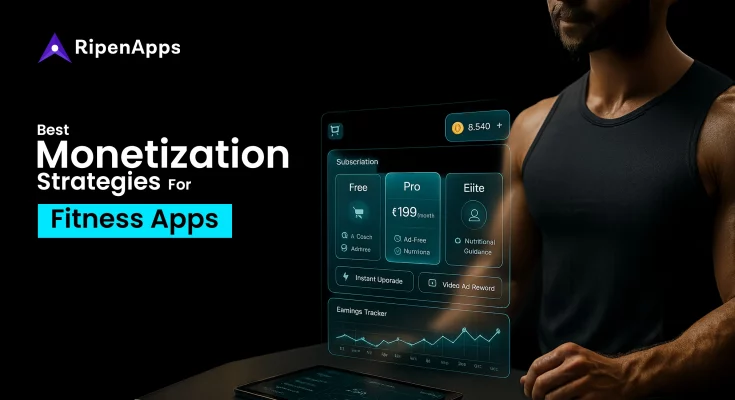Imagine a world where your audience skips prime-time TV to binge your content on their phones. That world? It’s today’s reality, which is powered by the unstoppable rise of over-the-top streaming services (OTT). From Netflix, Hulu, and Disney+, to hyper-niche platforms for fitness, faith, fashion, or fandom, OTT streaming platforms are not just transforming entertainment; they’re rewriting the playbook on content, convenience, and cash flow.
In 2025, over-the-top streaming services (OTT) will have become more than a digital alternative to cable. But the question is, what truly makes the best OTT platforms so successful? The answer lies in a unique blend of technology, creativity, monetization models, and above all, user obsession.
As media habits are evolving, building the next big OTT apps in USA isn’t just about content. It’s about understanding users, choosing the right OTT business model, and executing revenue strategies that don’t merely survive but scale.
So, if you are in the entertainment business or, startup looking to build OTT platforms, you must understand what makes the best OTT platforms successful. How do you choose between OTT subscription models vs freemium or ad-supported? What role does AI in OTT apps in retention? And how can startups develop a cost-effective OTT platform without burning through budgets?
In this blog, we’ll decode the blueprint, from business models to revenue strategies, to help you build a winning strategy for your OTT venture. Whether you’re exploring ideas or a startup eyeing OTT disruption, this guide breaks down how the top players win and how you can too. Let’s dive into it :
Table of Contents
Understanding the OTT Market in 2025
As per the latest reports of Fortune Business Insights, the global over-the-top (OTT) services market size is projected to grow from USD 70.08 billion in 2024 to USD 229.97 billion by 2032 at a CAGR of 16.0% during the year 2024-2032.
Driven by innovation and audience demand for anytime-anywhere content. In USA, the market is especially saturated with bottleneck competition, but also opens multiple opportunities for business owners. Emerging niches like regional language content, short-form storytelling, sports OTT, and educational streams are taking center stage and startups entering the market can take advantage of it.
OTT platforms in USA are investing in hyper-personalization, AI-powered recommendations, and immersive technologies like AR/VR. These are no longer just platforms; they are entertainment ecosystems, and you can also be one of them.
According to recent industry reports:
- Over 80% of U.S. households have at least one OTT subscription.
- The average viewer subscribes to 4–5 over-the-top services.
- By 2026, ad-supported OTT is expected to outpace subscription-based growth.
So, while Netflix and Hulu dominate headlines, there’s a rising wave of cost-effective OTT platforms thriving through niche focus and smart monetization. You can also discuss with a leading mobile app development company in USA to build a next-gen OTT platform and capture the market by having an edge over your competitors.
Key Features That Attract and Retain Users

OTT users today demand more than just streaming, they expect a seamless, intuitive, and hyper-personalized experience. Here are some must-have features that the best OTT apps in the market are offering:
1. Smart Personalization
AI and machine learning algorithms analyze user behavior to recommend highly relevant content. Integration of AI in OTT apps boosts engagement and retention to a great extent.
2. Buffer-Free Streaming
Adaptive streaming ensures content plays smoothly by adjusting video quality in real-time based on internet speed. Thus, it means no more frustrating lags.
3. Multi-device Sync
Users can start watching on their phone, pause, and pick up exactly where they left off on a smart TV or tablet. Integration of such features creates a seamless & cross-device experience.
4. Offline Viewing
Offering an offline viewing feature is a game-changer for users with limited connectivity or frequent travelers. Therefore, allowing downloads for on-the-go entertainment without data consumption.
5. Voice Search & Smart Remote Integration
Voice-first interfaces simplify navigation for users. One of the major advantages is that it makes it easier for users to find content hands-free, now a standard in smart OTT apps.
6. User Profiles & Parental Controls
Customized profiles and secure parental filters are must-haves to include in your OTT platforms. They are crucial for family-friendly platforms. Not only this, but it also offers personalized viewing and safe content curation.
The success of over-the-top streaming services lies in this balance of content richness and tech-enabled convenience. So, business owners need to pay attention to every aspect and launch an OTT platform. You can also seek help from a leading video streaming app development company to seamlessly integrate advanced features & functionalities into your app.
What Drives the Success of Leading OTT Platforms?
Now, before breaking down the business model & revenue strategies, let’s decode some of the best-known players in the market :
1. Netflix
The gold standard of over-the-top media service. No doubt that Netflix has completely mastered the game with:
- Proprietary AI-based content suggestions.
- Massive investment in original content.
- Transparent pricing in its OTT subscription models.
2. Disney+
Next comes Disney+, which leverages its existing media empire and brand loyalty. Its success stems from:
- Bundled subscriptions with Hulu and ESPN.
- Family-friendly catalog with strong IP (Marvel, Star Wars).
- User-friendly UI across platforms.
3. Amazon Prime Video
When it comes to Amazon Prime, it is more than an OTT service, it’s a value-add to Amazon Prime membership. The secret behind its success is due to :
- Deep integration into the e-commerce ecosystem.
- Free with other Amazon services.
- Localized content for global markets.
These above platforms don’t just stream, they create habit-forming ecosystems. Their strategic alignment of OTT business model with user needs is what sets them apart. You can also be a leader in the Entertainment sector.
Read Also: Cost To Develop an App like Netflix
Decoding Business Models of Popular OTT Platforms
OTT platforms can’t survive on views alone. A viable business model is key. Here are some business models of popular OTT platforms :
1. Subscription-Based (SVOD)
This model charges users a recurring fee, monthly or annually, to access a vast library of content. It ensures consistent revenue and works best for platforms offering high-quality series, films, or originals. Netflix and Disney+ thrive on this model by keeping viewers engaged over the long term.
- Example: Netflix, Disney+
- Recurring revenue, low churn with high content quality.
- Best suited for long-form, high-value content.
2. Advertising-Based (AVOD)
AVOD platforms offer content for free and generate income through targeted advertisements. This model is particularly effective in regions where users are unwilling to pay but still crave diverse entertainment options. Services like Tubi and Pluto TV are leading this ad-driven wabve.
- Example: Tubi, Pluto TV
- Free to users, monetized through OTT advertising platforms.
- Great for expanding the user base in emerging markets.
3. Transactional (TVOD)
In this setup, viewers pay individually for each movie or show they want to watch. It appeals to users looking for specific content without committing to a subscription. Platforms like Apple TV and Google Play have popularized this approach for new releases or niche films.
- Example: Apple TV, Google Play
- Pay-per-view model.
- Best for premium or limited-release content.
4. Hybrid Model
Combining the strengths of both SVOD and AVOD, the hybrid model caters to a broader audience by offering ad-supported and ad-free tiers. This flexibility attracts both premium users and budget-conscious viewers. Hulu and HBO Max have mastered this balanced strategy.
- Example: Hulu, HBO Max
- Mix of subscription and advertising.
- Flexibility in monetization.
5. Freemium Model
Freemium OTT platforms allow users to access a portion of the content at no cost, with premium upgrades unlocking more features or exclusive titles. This approach is great for rapid user onboarding and upselling through value-driven experiences. It’s a powerful strategy for market entry and scaling.
- Free tier with premium upgrades.
- Useful for quick market penetration.
Understanding these models is essential before starting your OTT venture.
Read Also: OTT App Development Guide
Revenue Strategies that Drive Profitability
The best OTT streaming platforms don’t only focus on capturing attention, but they also monetize it smartly. Here’s how top industry leaders structure their revenue models to drive long-term profitability:
1. AI-Powered Content Recommendations
By properly analyzing watch history, behavior, and preferences, technologies such as AI deliver hyper-relevant suggestions that keep users engaged longer. More screen time for users means more ad impressions, increased upsell opportunities, and a better retention rate. Therefore, making AI one of the most impactful levers in OTT monetization.
2. Targeted Advertising
The shift from traditional ads to programmatic, targeted ads has also played a crucial role in supercharging the value of ad slots. Several best OTT platforms like Roku and YouTube TV are at the forefront of OTT advertising platforms. They are delivering hyper-personalized campaigns that fetch premium rates. Also, brands pay more to reach the right user at the right time.
3. Tiered Subscriptions
Businesses can offer users multi-level plans such as ad-supported, ad-free, or premium with exclusive perks. Thus, it allows platforms to serve a wider audience. Whether it’s a cost-conscious student or a binge-heavy user, OTT subscription models offer flexible options that maximize revenue per segment.
4. Licensing & Syndication
Content isn’t merely for your platform. Licensing deals and syndication to other broadcasters or over-the-top services can create substantial passive income as well. This strategy extends reach while generating extra profit from high-performing originals or archives.
5. Exclusive Originals & Early Access
Nothing retains users better than content they can’t get anywhere else. Think HBO Originals or the buzz around Netflix series drops. Exclusive shows not only drive subscriptions, they attract binge-watchers who stick around longer for early releases and special access.
6. Bundle Packages
Bundling adds perceived value. Take Disney’s model, combining Disney+, Hulu, and ESPN+ into a single offer. That’s why this shows that bundles increase user retention, create cross-content discovery, and open the door to collaborative monetization with partner platforms.
7. Cross-Monetization
The smartest over-the-top media service providers don’t stop at only content. They’re building ecosystems. Think merch stores, affiliate links, live event streaming, gaming integrations, or in-app purchases, which are all layered within the user experience. These cross-monetization strategies multiply revenue streams and boost brand loyalty. So, you must give a try to such revenue strategies.
Building Your Own OTT Platform: What You Need
Successful launching your over-the-top streaming platform is no longer a dream. With the integration of right tech stack and a solid strategy, startups, and enterprises can enter the market with a cost-effective OTT platform tailored to their audience.
A scalable backend, an intuitive UI/UX design, adaptive video streaming capabilities, and robust security are some essentials for developing a feature-loaded OTT platform. Moreover, you can add must-have features like AI-powered content recommendations, multi-device sync, offline viewing, and tiered subscriptions to have a competitive edge.
Partnering with a globally recognized OTT app development company is crucial. The experts will guide you through the entire process, from platform architecture to post-launch analytics. Also, don’t forget compliance, CDN integrations, and user testing.
If you don’t have technical knowledge, do consult top OTT app development companies in USA that specialize in delivering tailored solutions.
You need to understand that building an OTT app or platform today isn’t just a tech project; it’s about a strategic move to claim your space in the future of entertainment.
Wrapping Up
In 2025, the success of the best OTT platforms will not only be limited to great content, but it will be powered by personalization, seamless emerging technologies, and flexible monetization. From AI-powered recommendations and adaptive streaming to tiered subscriptions and targeted advertising, leading platforms have mastered the art of engaging users while maximizing their revenue. Whether it’s through exclusive originals, bundle packages, or cross-monetization, their revenue strategies are built to scale and retain audiences in an increasingly competitive digital era.
For anyone looking to launch a cost-effective OTT platform, the roadmap is clear. You need to prioritize user-centric features, adopt smart business models, and partner with the right mobile app development company. They will help you to turn your idea into a profitable, scalable platform that is within reach. You can easily achieve success by blending innovation, experience, and strategy.
Frequently Asked Questions
Q1. What is the difference between OTT and traditional broadcasting?
OTT platforms allow you to deliver content over the internet without the need for traditional cable or satellite networks.
Q2. How much does it cost to build an OTT app?
The OTT app development cost depends on several factors. However, it typically ranges from $30,000 to $150,000+.
Q3. Which OTT business model is best?
There’s no one-size-fits-all. Subscription and hybrid models work best for most.
Q4. What’s the best way to monetize an OTT platform?
Combining advertising, subscriptions, and exclusive content is the best way to monetize an OTT platform. However, before choosing any one of these, discuss with an industry expert.
Q5. Can AI improve user engagement in OTT apps?
Absolutely. AI enhances personalization, recommendation, and content relevance. You must leverage emerging technologies like AI into your OTT app or platform.












 India
India USA
USA Australia
Australia Canada
Canada UK
UK UAE
UAE
